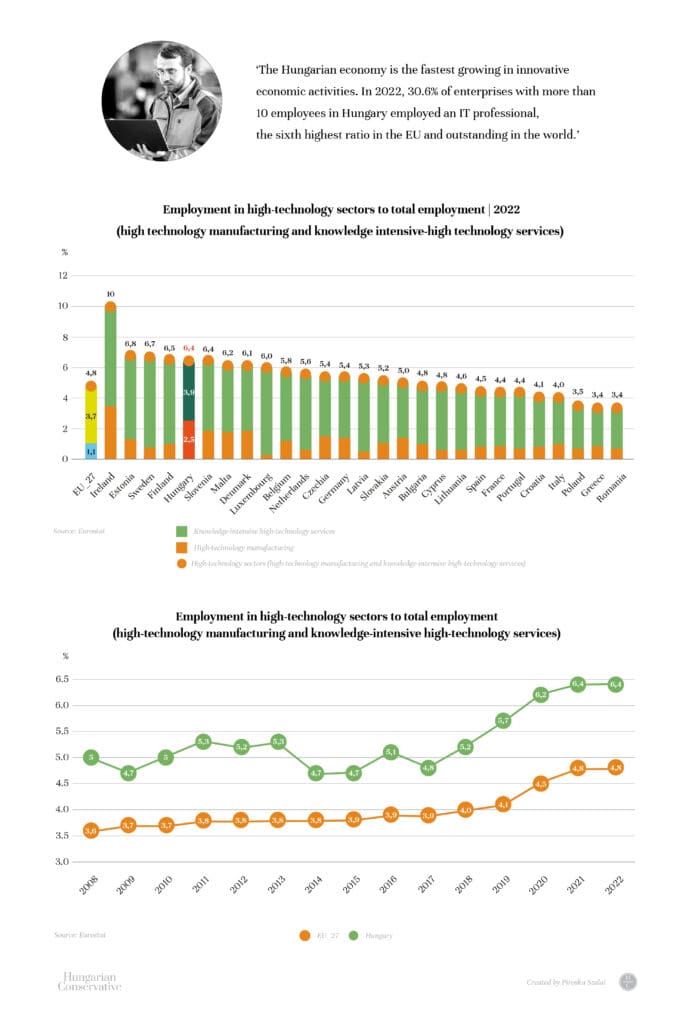Hungarian Conservative has launched a ten-part series of articles on the past decade and a half of the Hungarian economy and society, titled ‘Revealing the Facts’. Rather than looking at a lot of different, isolated data, it is worth providing an overview, comparing, and analysing trends over time, in order to understand the details. As we detailed in the previous parts, stable work and growing incomes), that is, the security of livelihood, are economically the most important for the Hungarian people. The improvement of living conditions, the reduction of poverty and the increase in family benefits has been the great achievements of recent years. Now inflation has not hit the Hungarian people as hard as it did during the regime change. Both the population and the economic players have been able to move forward, we have achieved substantial economic growth, which has been accompanied by a decade-long improvement in fertility. In the previous instalment our authors highlighted the turnaround in Hungary’s tax system after 2010. This article focuses on the history of innovation in Hungary.
One day we hear that we can solve any problem with our sharp minds, that we have the most Nobel Prize winners in relation to our population, and the next day we hear that Hungarian industry is not competitive enough and that our technologies are outdated. Let’s see, which of these statements is true?
How Innovative Are Hungarians?
It is a fact that until 2010 the Hungarian economy tried to compete on low wages, with many assembly plants. However, during the 2008 crisis, these factories moved to even cheaper countries, showing that this model was unsustainable. Instead, economic policy over the past decade has focused on high-tech, innovative, high value-added sectors to attract investment. As a result, the Hungarian economy is now much ‘smarter’ than ever before.
When is an enterprise innovative? A company is considered active in business innovation if it has improved its product, technology, distribution chain or organisation, i.e. innovated in some way, in the 12 months prior to the survey. Of course, while large companies tend to invest considerable energy and money in innovation, small and medium-sized enterprises are often said to be less active and less innovative due to various barriers.
But there are also very small and very innovative companies. In the world of SMEs, the flagships of business innovation are start-ups: new enterprises that offer an innovative product or service with high growth potential and that look to external markets from the outset. Their dynamism and example spill over to the rest of the economy, so they deserve more attention than their size or value-added capacity would warrant.
In 2019, analysts in London ranked the Hungarian capital as the best place in Europe for startups. ‘The work of Hungarian startups is world-class, even from an Israeli perspective. Hungary has the same most important resource as Israel: the human mind,’ said Yacov Hadas-Handelsman, the ambassador of Israel—often referred to as the startup nation—to Hungary after the virtual World Hackathon Day 2020, when he met Hungarian startups participating in the global event organized on Israel’s initiative.
To make even more efficient use of economic assets such as skilled labour and creativity, we need to further connect isolated solutions and strengthen synergies. Expert analysis shows that improving the links between the different actors in the ecosystem, such as universities, research institutes and companies, is the first challenge for the period ahead. The public sector will also have an important role to play in this platform-building, coordination, and organization of the ecosystem.
We know that internationally significant innovations can only be created where the local ecosystem is strong and supportive, where entrepreneurs and researchers are not alone with their ideas. Government has an important role to play in creating the environment for innovation. An EU survey shows that the role of the public sector is the fifth most important success factor for start-ups, after collaboration with other SMEs, large companies, universities, and other start-ups.
Hungary Among the Best
The number and proportion of students in tertiary education has increased the most over the last fifteen years among all fields of education in computer science and natural sciences, so there is a large number of skilled and well-qualified technical professionals in Hungary. According to HackerRank, a site that helps companies recruit and test programmers, the top countries in the world for programmers are China, Russia, Poland, Switzerland and Hungary.
Hungary also has the fifth highest share of people employed in high tech manufacturing and knowledge-intensive services in Europe, at 6.4 per cent. Within this, the share of women working in high tech industries is the highest in the EU, tied with Ireland at 2.7 per cent.

We have already presented employment growth in Hungary. Since 2017, the number of people employed in the high-tech sector has increased more than the significant increase in the number of people employed, and their share has also increased. This is the period when we were propelled into the EU lead. Although the growth of the EU average accelerated due to the COVID-19 pandemic, we were able to increase our lead even in these years. While in 2017 we were 0.9 percentage points above the EU average, by 2021 our lead had increased to 1.6 percentage points, as the graph above shows. During this time, the number of people working in the sector increased by a third to 300,000.
Not only does the high-tech sector have a significant impact on employment, but its share in foreign trade is even higher: in 2022, the high-tech sector accounted for 16 per cent of our imports and 14.8 per cent of our exports. Its share of imports is the fifth largest in the EU, behind Malta, Ireland, the Netherlands and the Czech Republic, and its share of exports is the seventh largest, with France and Belgium ahead of us, and the four countries mentioned above.
The Hungarian economy is the fastest growing in innovative economic activities. In 2022, 30.6 per cent of enterprises with more than 10 employees in Hungary employed an IT professional, the sixth highest ratio in the EU and outstanding in the world.
We are justifiably proud of Hungarian talent, we think we can find solutions to any problem, and we hear the same remarks from foreigners. So, we should start believing that Hungary can be at the forefront of innovation. Our traditions provide a solid foundation and background for the inventions that are being born.
Piroska Szalai is a labour market expert, a researcher at Economy and Competitiveness Research Institute of the Ludovika University of Public Service.
Mátyás Zsolt Varga is a journalist at Mandiner.
Related articles:








